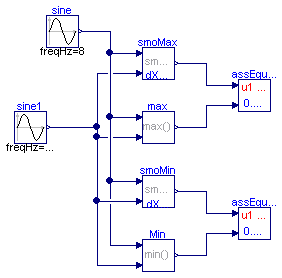Extends from Buildings.BaseClasses.BaseIconExamples (Icon for Examples packages).
| Name | Description |
|---|---|
| RegNonZeroPower | |
| RegNonZeroPowerDerivative_2_Check | |
| RegNonZeroPowerDerivativeCheck | |
| SmoothBlocks | |
| SmoothExponentialDerivativeCheck | |
| SpliceFunction | |
| SpliceFunctionDerivativeCheck |
model RegNonZeroPower Real y "Function value"; equation y=Buildings.Utilities.Math.regNonZeroPower(time, 0.3, 0.5); end RegNonZeroPower;
This example checks whether the function derivative is implemented correctly. If the derivative implementation is not correct, the model will stop with an assert statement.
| Type | Name | Default | Description |
|---|---|---|---|
| Real | n | 0.33 | Exponent |
| Real | delta | 0.1 | Abscissa value where transition occurs |
model RegNonZeroPowerDerivative_2_Check parameter Real n=0.33 "Exponent"; parameter Real delta = 0.1 "Abscissa value where transition occurs"; Real x; Real y; initial equation y=x; equation x=Buildings.Utilities.Math.BaseClasses.der_regNonZeroPower(time,n, delta, time); der(y)=der(x); assert(abs(x-y) < 1E-2, "Model has an error"); end RegNonZeroPowerDerivative_2_Check;
This example checks whether the function derivative is implemented correctly. If the derivative implementation is not correct, the model will stop with an assert statement.
| Type | Name | Default | Description |
|---|---|---|---|
| Real | n | 0.33 | Exponent |
| Real | delta | 0.1 | Abscissa value where transition occurs |
model RegNonZeroPowerDerivativeCheck parameter Real n=0.33 "Exponent"; parameter Real delta = 0.1 "Abscissa value where transition occurs"; Real x; Real y; initial equation y=x; equation x=Buildings.Utilities.Math.regNonZeroPower(time,n, delta); der(y)=der(x); assert(abs(x-y) < 1E-2, "Model has an error"); end RegNonZeroPowerDerivativeCheck;

model SmoothBlocks SmoothMax smoMax(deltaX=0.5); Modelica.Blocks.Math.Max max; Modelica.Blocks.Sources.Sine sine(freqHz=8); Modelica.Blocks.Sources.Sine sine1; Diagnostics.AssertEquality assEquMax(threShold=0.08); SmoothMin smoMin(deltaX=0.5); Modelica.Blocks.Math.Min Min; Diagnostics.AssertEquality assEquMin(threShold=0.08); equation connect(sine.y, smoMax.u1); connect(sine.y, max.u1); connect(sine1.y, smoMax.u2); connect(sine1.y, max.u2); connect(smoMax.y, assEquMax.u1); connect(max.y, assEquMax.u2); connect(sine.y, smoMin.u1); connect(sine.y, Min.u1); connect(sine1.y, smoMin.u2); connect(sine1.y, Min.u2); connect(smoMin.y, assEquMin.u1); connect(Min.y, assEquMin.u2); end SmoothBlocks;
This example checks whether the function derivative is implemented correctly. If the derivative implementation is not correct, the model will stop with an assert statement.
model SmoothExponentialDerivativeCheck Real x; Real y; Real ex "exact function value"; initial equation y=x; equation x=Buildings.Utilities.Math.smoothExponential(x=time-2, delta=0.5); der(y)=der(x); assert(abs(x-y) < 1E-2, "Model has an error"); ex=exp(-abs(time-2)); end SmoothExponentialDerivativeCheck;
model SpliceFunction Real y "Function value"; equation y=Buildings.Utilities.Math.spliceFunction(10, -10, time+0.1, 0.2); end SpliceFunction;
This example checks whether the function derivative is implemented correctly. If the derivative implementation is not correct, the model will stop with an assert statement.
model SpliceFunctionDerivativeCheck Real x; Real y; initial equation y=x; equation x=Buildings.Utilities.Math.spliceFunction(10, -10, time+0.1, 0.2); der(y)=der(x); assert(abs(x-y) < 1E-2, "Model has an error"); end SpliceFunctionDerivativeCheck;